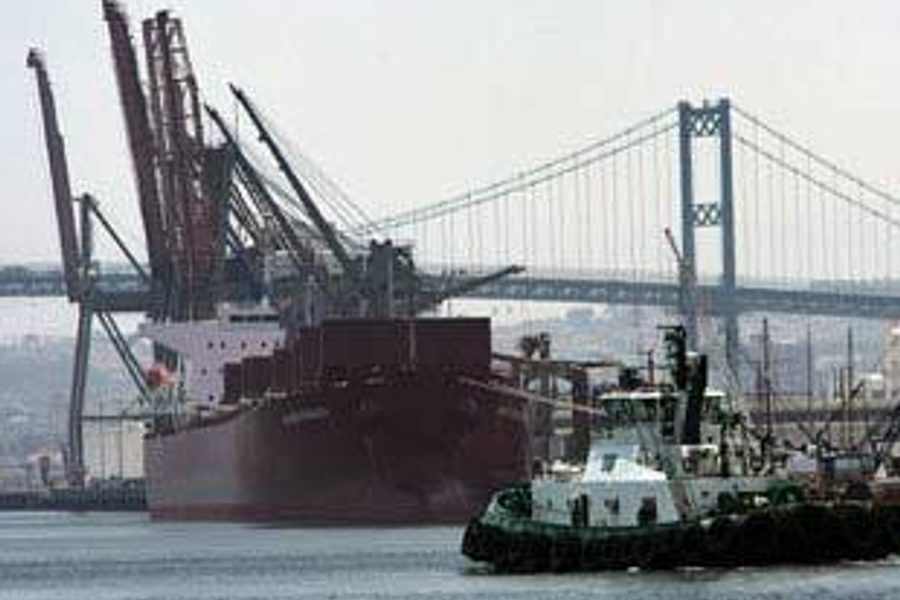Air Polluters Sail the High Seas
The environmental law firm EarthJustice, Friends of the Earth and other advocacy groups are taking action to compel the EPA to set comprehensive restrictions on the air pollution that clouds U.S. harbors
Michelle Chen

A threat to the world’s atmosphere is sailing the high seas, but activists say government regulators are letting the culprit off the hook.
The global shipping industry coughs up millions of tons of air pollution each year, yet its emissions are for the most part unregulated, aside from minimal international standards. Now, environmental groups are turning the country’s seaports into a fresh battleground in the climate-change debate, demanding that the Environmental Protection Agency (EPA) rein in marine engines under the Clean Air Act.
The environmental law firm EarthJustice, Friends of the Earth and other advocacy groups are taking action to compel the EPA to set comprehensive restrictions on the air pollution that clouds U.S. harbors. In a recently filed lawsuit and administrative petition, environmentalists argue the Clean Air Act mandates the government to confront health-damaging soot as well as greenhouse gases emitted by shipping vessels.
Though cars and industrial plants are more notorious for contributing to global warming, cargo ships are also heavyweight polluters. Researchers with the German Aerospace Center and University of Delaware estimate that ocean ships dump between 600 million and 900 million metric tons of carbon dioxide into the atmosphere annually. That’s comparable to the total yearly emissions of countries like Germany or Canada.
“Ships have traditionally gone below the radar, in part because they’re kind of ‘out there,’” says Jackie Savitz, pollution campaign director with the environmental organization Oceana. “We rarely drive by them on our way home from work.”
But ship smokestacks loom large in the warming atmosphere. The industry’s fuel consumption could soar by more than 70 percent between 2000 and 2020, according to the International Maritime Organization (IMO), a policy-making body that sets international pollution guidelines. Big ships also annually spew tens of thousands of tons of “black carbon,” or heat-trapping soot, and about 27 percent of worldwide nitrogen-oxide emissions. One EPA study projected that in the United States alone, nitrogen-oxide emissions from large ships would nearly triple from 1996 to 2030.
Environmentalists say the federal response to the problem has been glacially slow. In 2003, following a legal challenge by environmental groups, the EPA set a mandatory April 2007 deadline to establish standards for large vessels under the Clean Air Act. But the agency recently pushed back the process until late 2009, claiming it needs more time to collaborate with the IMO in revising global emission limits. The International Council on Clean Transportation (ICCT), an advisory organization, recently reported that current international standards for nitrogen oxide and other pollutants “merely codify existing industry practices.”
Danielle Fugere, Friends of the Earth’s global-warming program director, says federal regulators can still take action while international negotiations are pending. “EPA can’t pawn off its duties under the Clean Air Act to some international body,” she says. “It has an obligation to protect the U.S. citizens and to regulate industry to protect our air quality.”
In deferring to international authority, the EPA stresses that most ships entering U.S. ports are based out of foreign countries. However, according to legal analyses by the European Commission and ICCT, national and state governments have regulatory powers over both foreign and domestic ship pollution within territorial waters. E.U. nations have accordingly initiated plans to restrict emissions surrounding their ports.
California has followed suit, issuing landmark rules last year to cap pollution from ships in local waters. Meanwhile, in Congress, pending bills introduced by Sen. Barbara Boxer (D-Calif.) and Rep. Hilda Solis (D-Calif.) set goals for emissions reductions and cleaner fuels for all vessels operating in U.S. harbors.
Even some industry interests concede they have escaped regulation for too long. Joseph Cox, president of the trade association Chamber of Shipping of America, a trade association, acknowledges existing IMO regulations “are not strong enough,” and that shipping companies prefer, a long-term, “uniform national standard” over patchwork of localized state rules.
Various solutions abound for curbing air pollution. Ships could use cleaner-burning fuel, rather than the typical sulfur-laden diesel known as “bunker oil,” which can be about 1,800 times dirtier than standard highway diesel. More energy-efficient vessel designs and speed limits would streamline fuel consumption. Internationally, regulators could implement global pollution caps as well as emissions trading for ships.
“The shipping industry has been able to get away with operating without regulations, and without having to internalize the cost of the impacts that its activities have on these communities,” says EarthJustice attorney Sarah Burt. “The EPA’s regulation of pollution from these ships is long overdue.”
Michelle Chen is a contributing writer at In These Times and The Nation, a contributing editor at Dissent and a co-producer of the “Belabored” podcast. She studies history at the CUNY Graduate Center. She tweets at @meeshellchen.









